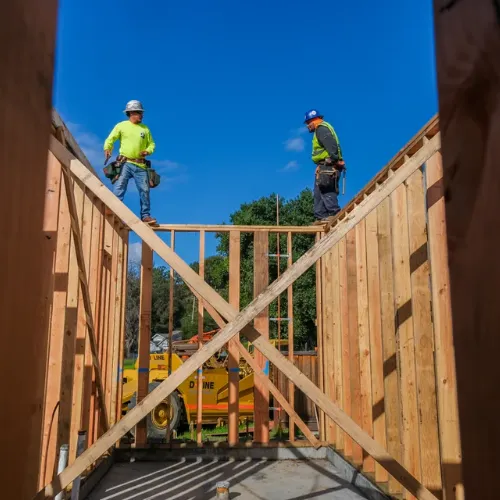
California housing legislation has long faced fierce resistance from organized labor, but the California Conference of Carpenters took a different approach — and it’s changing the debate.
When Gov. Gavin Newsom signed the state’s biggest housing red-tape rollback in years, he gave them credit directly: “This is the third of the last four years we’ve been together signing landmark housing reforms, and it simply would not have happened without the Carpenters,” he said.

The new law scales back parts of California’s landmark environmental review process, exempting urban apartment developments from some hurdles — an idea that was once a political non-starter. It’s the latest in a string of pro-housing bills that lawmakers passed with the Carpenters’ critical backing.
Their support gave some Democratic lawmakers cover to push ambitious housing production goals without fully clashing with construction labor. “Unions carry a lot of weight in Sacramento and for good reason,” said Assemblymember Buffy Wicks, an Oakland Democrat. “It’s important that we’re supporting good-paying jobs… But we have to look around at what’s working and we have to build 2.5 million homes. The Carpenters have come to the table with more creative solutions.”
But their position hasn’t been without controversy. Other construction unions, grouped under the powerful State Building and Construction Trades Council, oppose most housing streamlining proposals unless they include prevailing wages and union hiring mandates that many developers say make building more housing cost-prohibitive.
“The Carpenters, in my view, are a pariah in the labor movement,” said Scott Wetch, a lobbyist for Trades-affiliated unions. “They’re willing to sell all workers down the river and pursue really unlivable wage rates so they can try to capture other unions’ work.”

The Carpenters counter that they’re focused on lifting up non-union residential workers who already dominate housing construction. “The role of unions is to protect the workers in their organization,” said Danny Curtin, director of the California Council of Carpenters. “But in the larger perspective, it’s to protect all workers, and then bring them into the union movement.”
Sen. Scott Wiener, a major backer of the housing bills, said the Carpenters’ shift under Northern California leader Jay Bradshaw “changed everything. It created more space for more dialogue and less of the ‘my way or the highway’ approach.”
The latest law passed after a dramatic fight over a wage proposal that would have set new minimum pay standards for residential construction — higher than typical non-union pay, but lower than full prevailing wages. The backlash was swift. “This here, this time, was just a complete non-starter,” said Chris Hannan, president of the Trades Council.
In the end, lawmakers dropped the controversial wage provision but kept some labor enforcement language that could help the Carpenters target wage theft and lift standards for non-union workers.
“Count us shoulder-to-shoulder with anyone who will continue to drive to pull those workers up and in, as they should be… but to make sure that union labor should be held to account to represent all workers,” Bradshaw said at the signing ceremony.
The Carpenters’ rift with the broader Trades echoes deeper questions about the future of labor organizing in a changing construction market. While commercial and public works are still mostly union-built, residential construction has operated in what labor historians call the “Wild West,” with a fragmented workforce, widespread wage theft, and low rates of unionization.
By focusing on non-union residential sites — “crime scenes,” as Bradshaw calls them — the Carpenters hope to expand their reach while tackling some of the worst abuses. It’s a strategy similar to what the Service Employees International Union did with its Fight for $15 campaign, which organized fast food workers and won major wage hikes without requiring them to be union members first.
The stakes are high: California needs millions of new homes to ease its affordability crisis, but each housing bill comes with tough trade-offs on labor standards, local control, and environmental protections.
“The Carpenters have given us a path to negotiate,” said Sen. Wiener. But as Chris Hannan of the Trades Council put it, “There’s a lot of work to be done there.”
Whether more unions follow the Carpenters’ lead — or resist — will shape how, and how fast, California builds the housing it desperately needs.
Originally reported by Jeanne Kuang and Ben Christopher in Cal Matters.